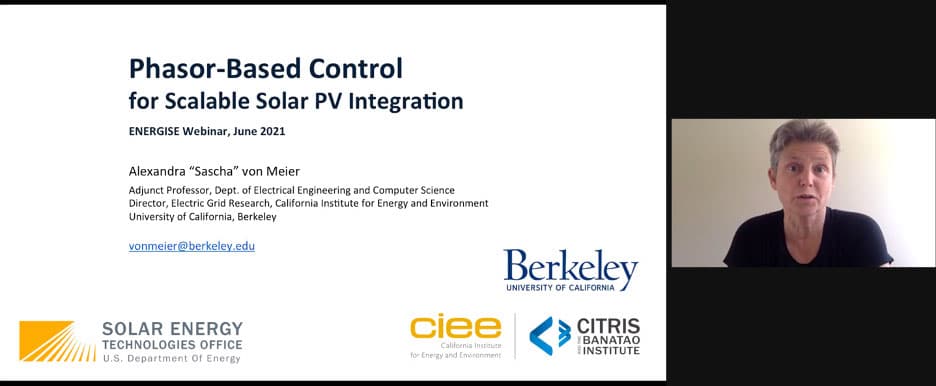On June 24, 2021, Professor Sascha von Meier gave a presentation for the US DOE’s Solar Energy Technologies Office (SETO)’s webinar series about new projects that are working to enable greater solar energy integration in the electric grid. Sascha’s talk focused on a new framework termed phasor-based control (PBC) that has the important potential to facilitate integration of distributed energy resources (DER) such as solar photovoltaics into the grid, therefore promoting the critical transition to low-carbon energy systems. This exciting new technology, Sascha explained, is the result of nearly a decade of work led by the team at CIEE and a large group of partners from research groups in academia as well as the in the private sector, with the concept developed and proven under a DOE ENERGISE grant.
The technology, Sascha described, is enabled through a series of synchronized, high-precision voltage measurements that provide “grid-specific, rather than resource-specific, terms.” Sascha’s team developed a device to measure voltage phasors—or signals—to identify the operating state of the grid in terms of power flows at precise points throughout the network. This ‘layered’ feedback control framework allows both “real-time monitoring and two-way grid communication, so PBC can facilitate renewable integration and improve grid reliability and resilience by rapidly compensating for system disturbances”—but without compromising privacy. Specifically, Sascha explained, by first measuring a phasor at a certain point and taking it as representative of where the system should be in equilibrium, when something causes the phasor to deviate from that position, “you can recruit DERs—which would include both loads and energy consuming devices as well as energy generating devices—to try to restore the phasor to its equilibrium position.”
A unique feature of the technology is that by providing direct measurements to represent the state of grid without having to go through a price signal communication, PBC provides real-time data on the state of the grid and two-way communication with the grid.
The team is currently testing the novel approach in wide range of situations. The ability to achieve “optimal power flow hinges on our ability to measure, and microPMU technology makes it possible to measure and communicate voltage with high accuracy.” Importantly, PBC would enable grid operators to “respond pretty much in real time – and correct for neighbors’ volatility by looking at total net power flow,” but because this data does not provide the location but rather shows changes in all power flows between the substation and resource station, it ensures that residents’ specific information is kept private.
The technology design would enable a data infrastructure that would be scalable, with multiple resources owned and operated by different parties—and importantly, communication between parties that, Sascha emphasized, “don’t have knowledge of each other’s private details yet can still cooperate and achieve an optimal outcome.”

